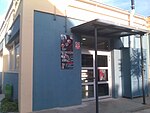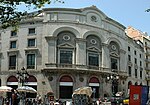Plaça del Duc de Medinaceli
Ciutat VellaPlazas in Barcelona

Plaça del Duc de Medinaceli is a square in central Barcelona. It is part of Barri Gòtic, in the Ciutat Vella district, located between Passeig de Colom and Carrer de la Mercè, on a terrain formerly part of a 13th-century Franciscan convent until 1836. The square was projected after the disappearance of the old city walls and the convent in the 19th century. It is named after the 16th century nobleman Luis de la Cerda y de la Vega, count of Medinaceli, Cogolludo and Arcos de Jalón, a descendant of the Montcada family, who gave away the terrain to the Franciscans.
Excerpt from the Wikipedia article Plaça del Duc de Medinaceli (License: CC BY-SA 3.0, Authors, Images).Plaça del Duc de Medinaceli
Passeig de Colom, Barcelona
Geographical coordinates (GPS) Address Website Nearby Places Show on map
Geographical coordinates (GPS)
| Latitude | Longitude |
|---|---|
| N 41.378203 ° | E 2.179273 ° |
Address
Punt Verd Mòbil *Plaça Duc Medinaceli - Passeig Colom
Passeig de Colom
08001 Barcelona (Ciutat Vella)
Catalonia, Spain
Open on Google Maps









